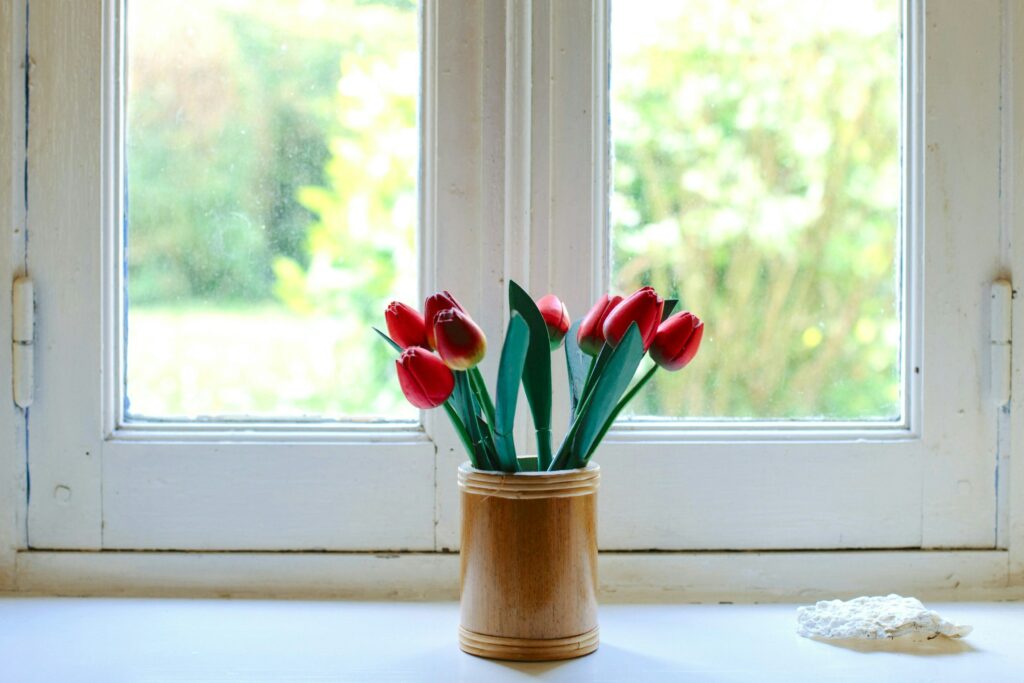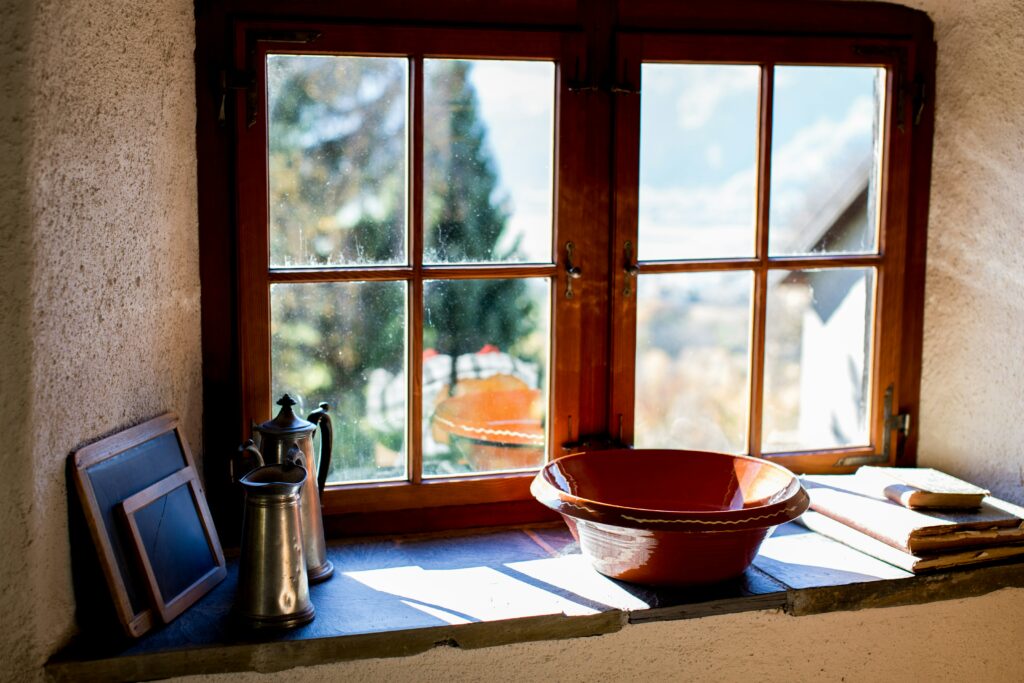If you’ve ever noticed cloudy spots or chalky streaks on your windows or glass doors that don’t wipe away easily, you’re likely dealing with hard water stains. But what causes hard water stains, and why are they so stubborn to remove?
In this guide, we break down the science behind hard water, how it interacts with surfaces, and practical steps to prevent or treat these common issues, especially for homeowners and businesses in West Michigan.
Here’s What You’ll Learn in This Post
- The science behind hard water and its effects
- What causes hard water stains on glass and other surfaces
- Environmental and household factors that make stains worse
- Prevention strategies for homes and commercial buildings
- Tips for cleaning and reducing future staining
- When to call a professional cleaning service
Understanding the Problem: What Is Hard Water?
Before exploring stain prevention and treatment, it’s important to understand what is hard water. Hard water refers to water that contains high concentrations of dissolved minerals, primarily calcium and magnesium. These minerals are naturally present in groundwater and vary significantly by region.
West Michigan, including cities like Byron Center, is known for having mineral-rich water sources. While hard water is safe to drink, it can be a nuisance for cleaning because it leaves mineral deposits behind, especially when water evaporates from glass surfaces.
The effects of hard water go beyond just windows. Mineral buildup can accumulate in plumbing systems, reduce the efficiency of appliances like dishwashers and water heaters, and cause soap scum in bathrooms. It can even make your laundry feel stiff or leave your skin dry after showering.
Water hardness is commonly measured in grains per gallon (GPG). Water is considered “hard” when it exceeds 7 GPG. Knowing your water’s mineral content can help guide the right preventive steps for your home.
Additionally, while homes with private wells are more likely to experience hard water, municipal water supplies in parts of West Michigan can also be quite hard depending on the source. Whether your home is on a well or city system, it’s important to understand how water quality impacts your windows and other surfaces.
What Causes Hard Water Stains?
The main factor behind hard water stains is the evaporation of mineral-laden water droplets. When water with a high mineral content lands on a surface and dries, it leaves behind tiny residues of calcium and magnesium. These appear as white or cloudy spots, streaks, or film on glass, tile, metal, and other smooth surfaces.
Several situations can contribute to hard water staining:
- Sprinkler overspray: Outdoor windows near lawns often get hit with sprinkler water that dries and leaves behind deposits.
- Showering or steam: Bathrooms are common sites for hard water stains due to frequent water use and high humidity.
- Window condensation: On cooler days, condensation can form on windows and dry up slowly, giving minerals more time to settle.
- Poor drainage or runoff: Improperly directed gutters or poor landscaping can cause water to pool or splash onto walls and windows.
Each of these situations increases the exposure of glass to evaporating mineral-heavy water, which is ultimately what causes hard water stains to develop and accumulate over time.
Why These Stains Are So Difficult to Remove

Unlike everyday dust or grime, hard water stains are made up of mineral deposits, primarily calcium and magnesium, that leave behind a chalky or cloudy residue. What makes these deposits especially difficult to remove is how they bond to the surface. As the water evaporates, the minerals solidify and form a chemical connection with the glass or metal they come into contact with. This bond is much stronger than the light surface attachment of typical dirt, making the stains more resistant to basic cleaning methods.
A quick wipe or use of a standard glass cleaner often has little effect. In some cases, using the wrong tools, such as rough sponges or stiff brushes, can scratch the glass or remove protective coatings. This not only fails to eliminate the stains but can make the glass more vulnerable to future damage.
Time is also an important factor. The longer these mineral deposits are left untreated, the more they settle into the material. Over time, they can cause etching, which creates a cloudy, dull appearance that is often permanent.
Direct sunlight can worsen the problem. When water containing minerals dries quickly in the sun, it speeds up the bonding process and makes the deposits harder to remove. This is why stains that appear light at first can become much more stubborn if they are exposed to sun and heat for extended periods.
In short, hard water stains are challenging to clean because of their chemical nature, how firmly they attach to surfaces, and how environmental conditions can intensify the problem. Professional-grade cleaners or expert help is often required to fully restore the clarity of the glass.
Contributing Factors You Might Overlook
There are several household or environmental conditions that can make hard water stains worse or more likely to appear:
- High mineral content in well water
- Lack of water softening systems
- High humidity environments
- Frequent use of glass surfaces for water-based activities (showers, hoses, etc.)
- Homes near construction sites or farmlands where dust combines with moisture
Knowing these factors can help you better understand not just what causes hard water stains, but why they seem to return so quickly in some homes.
Preventive Steps to Protect Your Windows and Fixtures
Preventing stains is easier and less expensive than removing them. Here are a few tips to reduce your exposure to mineral buildup:
- Use a squeegee after showers or water exposure: Removing water right away prevents minerals from settling.
- Redirect sprinkler systems: Ensure no water is spraying directly onto windows or siding.
- Install water softeners: These systems can significantly reduce the amount of calcium and magnesium in your water supply.
- Keep windows shaded or covered during cleaning: Avoid working in direct sunlight when rinsing windows.
- Regularly clean exterior surfaces: Routine upkeep prevents buildup from becoming permanent.
Best Practices for Cleaning Hard Water Stains
If stains have already formed, removing them requires the right approach. Avoid using abrasive tools that can scratch glass or damage coatings. Instead, try:
- A vinegar and water solution: A natural, acidic cleaner that can dissolve mineral deposits.
- Commercial hard water stain removers: Choose products designed specifically for calcium and lime buildup.
- Soft cloths or non-scratch pads: Always pair cleaning products with gentle materials.
- Drying glass thoroughly: Use a clean microfiber towel after cleaning to prevent new spots from forming.
When to Bring in a Professional Team
While some stains can be removed with patience and the right products, older or widespread mineral buildup often requires expert attention. Teams experienced in window cleaning services use commercial-grade tools and specialized solutions that can safely restore clarity without damaging the glass.
If you’re located in an area like Byron Center, where water tends to have a high mineral content, turning to local experts in window cleaning in Byron Center can be especially beneficial. These professionals understand regional water conditions and can recommend targeted treatments and long-term prevention strategies.
In addition to removing tough stains, a professional window cleaner can assess potential long-term damage, apply protective coatings, and help you avoid common pitfalls, like using overly harsh chemicals or excessive pressure that can harm the surface.
Clarity Starts with Understanding What You’re Up Against

Many homeowners are surprised to learn that stubborn streaks or cloudiness on their windows are not just leftover dirt or dust, but the result of mineral deposits from their own water supply. Hard water, while safe to use and consume, leaves behind calcium and magnesium that bond to glass and other surfaces. Over time, these deposits can dull the appearance of your home and even contribute to long-term etching or staining if left untreated.
Addressing hard water stains starts with awareness. When you understand how these marks form and what everyday habits or environmental factors contribute to them, you’re in a much better position to prevent damage before it becomes permanent. Routine cleaning, careful water management, and the use of protective treatments all work together to maintain your windows in peak condition.
Whether you prefer a do-it-yourself strategy or professional assistance, staying proactive is the key to preserving your property’s appearance. By identifying risk factors early and responding with the right tools and techniques, you can keep your glass surfaces looking clear and polished in every season.
Ultimately, protecting your windows begins with knowing what causes hard water stains and how to keep them from taking hold.
